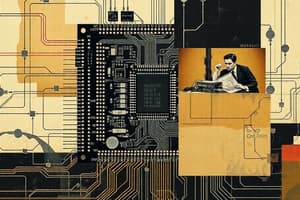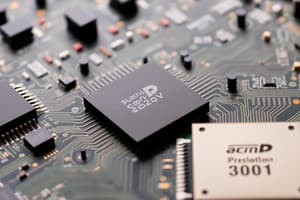Podcast
Questions and Answers
What is the purpose of the address bus in a microcontroller?
What is the purpose of the address bus in a microcontroller?
- Convert analog signals to digital form
- Transmit memory addresses from CPU to memory (correct)
- Refresh the watchdog timer
- Transmit data from CPU memory
What happens when a microcontroller program fails to refresh the watchdog timer?
What happens when a microcontroller program fails to refresh the watchdog timer?
- Serial communication is interrupted
- An analog-to-digital conversion failure occurs
- A reset occurs (correct)
- The timer unit stops functioning
What is the role of Flash EEPROM in a microcontroller?
What is the role of Flash EEPROM in a microcontroller?
- Transmit memory addresses from CPU to memory
- Connect all blocks inside the microcontroller
- Erasable Programmable Read Only Memory (correct)
- Convert analog signals to digital form
How does Serial Communication benefit a microcontroller?
How does Serial Communication benefit a microcontroller?
When would an Analog Comparator be used in a microcontroller?
When would an Analog Comparator be used in a microcontroller?
What components are integrated onto a single chip in a microcontroller?
What components are integrated onto a single chip in a microcontroller?
What is the significance of the prefix 'MICRO' in 'microcontroller'?
What is the significance of the prefix 'MICRO' in 'microcontroller'?
What type of module allows a microcontroller to perform tasks for certain time periods?
What type of module allows a microcontroller to perform tasks for certain time periods?
What does ADC stand for in the context of a microcontroller?
What does ADC stand for in the context of a microcontroller?
Which component of the microcontroller traditionally serves as memory locations?
Which component of the microcontroller traditionally serves as memory locations?
Flashcards are hidden until you start studying
Study Notes
Microcontroller Overview
- A microcontroller is a single chip that integrates a microprocessor system, requiring only power and clocking.
- The term "micro" comes from the Greek word "Micros", meaning small in size, quantity, number, and dignity.
Components of a Microcontroller
- A microcontroller combines the CPU core, memory (ROM and RAM), and parallel digital I/O on a single chip.
- Other components often included are:
- Timer module
- Serial I/O
- Analog-to-Digital Converter (ADC)
- Analog Comparator
CPU Core
- The CPU core is the heart of the microcontroller.
- Traditionally based on an 8-bit microprocessor unit.
- Registers serve as memory locations, enabling mathematical operations and data processing.
Memory
- Memory is responsible for storing data.
- Types of memory:
- Volatile RAM (Random Access Memory)
- Non-Volatile ROM (Read Only Memory)
- EPROM (Erasable Programmable Read Only Memory)
- EEPROM (Electrically Erasable Programmable Read Only Memory)
- Flash EEPROM
Bus
- A bus represents a group of wires (8, 16, or more) that connect blocks inside the microcontroller.
- Two types of buses:
- Address bus: transmits addresses from CPU to memory.
- Data bus: transmits data, as wide as the data (8 bits, etc.).
Timer Unit
- A timer unit is a counter driven by an external clock pulse or the microcontroller's internal oscillator.
- Watchdog timer: a timer that is refreshed by the user program, resetting if not refreshed.
Serial Communication
- Serial communication (RS232) enables microcontrollers to connect to other microcontrollers or PCs using a serial cable.
Analog-to-Digital Converter (ADC)
- An ADC converts analog signals (e.g., voltage) to digital form for microcontroller processing.
Analog Comparator
- Analog comparators are used to compare two analog voltages.
Studying That Suits You
Use AI to generate personalized quizzes and flashcards to suit your learning preferences.



